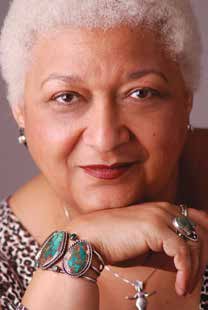
By Jewelle Gomez–
Lesbians have been thinking about eternal life ever since Sheridan Le Fanu’s vampire novella Carmilla was published in 1872. Then Anne Rice’s 1976 novel, Interview with the Vampire, introduced the queer male vampire and nothing has ever been the same. When I started writing my own vampire novel, The Gilda Stories, I read and re-read all of the classics from Bram Stoker’s Dracula to Chelsea Quinn Yarbro’s Count Saint Germaine series and Stephen King; as well non-fiction explorations of international vampire myths. My novel was a response to wanting to see a lesbian of color embark on the adventure of eternal life. Interview with the Vampire still stands out boldly as an epic horror tale of queer desire and danger.

One of my first friends in San Francisco, the late writer/editor Eric Garber, organized a queer trip to the movies for the 1994 opening of the film version of Interview with the Vampire. We were excited to see the iconic story on screen, but, alas, there was something distinctly missing. It was like the heart of the narrative had been ripped out, and not in a good way!
Sensuality, the propulsion for Rice’s story on the page, was strangely absent on the screen. Chemistry between actors and how it’s captured on film (or video) is a unique and mysterious thing. Sometimes even directors like Neil Jordan (The Crying Game), who did that version of Interview with the Vampire, might not have been able to fan a flame. Even the still shots featuring Tom Cruise and Brad Pitt look like the actors are discussing golf scores rather than deciding which coffin they’ll sleep in tonight.
With Halloween on the horizon, I’m excited to say that a new version of Rice’s book will soon be streaming. It’s cool and it’s hot! The creators have taken full advantage of the locale of the novel, New Orleans, by exploring the milieu of honkytonks and bordellos where music and people pulsed through the night. The heat and danger of the city in the early 20th century are palpable.

The creators also don’t ignore its international flavor: free people of color, those who were still enslaved, creoles, and Irish immigrants are all a part of the teeming masses on screen, as they were historically. This gives the series a vibrant texture and underpins the casting of Jacob Anderson, a man of color, as Louis. A casting departure from the earlier version, it will no doubt rankle some purists. (Insert my shrug here.)
The sensuality of vampire life, equally important, is highlighted rather than muted as it was in the earlier film version. For beings whose senses are exorbitantly heightened once they are transformed from mortal to immortal, the flame of a single candle can become an absorbing epic. This series captures all of the sensory sensations in the casting of Anderson and of Sam Reid as Lestat. The chemistry between them is combustible as befits two of the most exciting queer characters in literature.
I imagine it wasn’t easy for a mainstream film to be as definitive about their desire in the early 1990s. This streaming version makes up for that tepid temperature by more than a few degrees. Compulsion, love, lust, and blood are all gleaming in Lestat’s eyes as he seduces Louis with something we all want: to live without shame.

The horror genre holds a fascination for many of us because it is so perfectly suited for telling queer stories. The characters can embody both outsider status and at the same time strive for and gain personal power. A new streaming docuseries called Queer for Fear (https://tinyurl.com/ykhxmtzh) explores just how much we love our spooky stories.
Given the regressive direction politicians are taking, we might need Lestat and other supernaturals on our side in this century. Just remember you have to invite the vampire in first!
Jewelle Gomez is a lesbian/feminist activist, novelist, poet, and playwright. She’s written for “The Advocate,” “Ms. Magazine,” “Black Scholar,” “The San Francisco Chronicle,” “The New York Times,” and “The Village Voice.” Follow her on Instagram and Twitter @VampyreVamp
Leave Signs
Published on October 6, 2022
Recent Comments